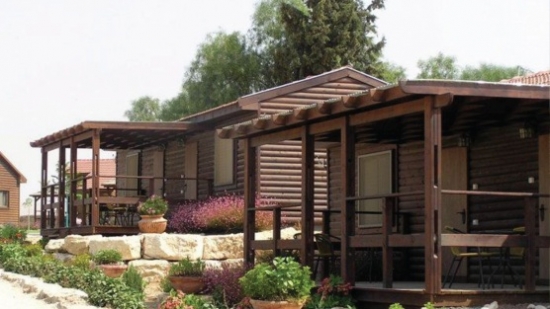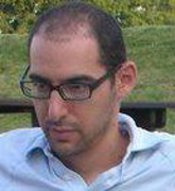
KRAMIM: a vision in the Negev
Our family plans to celebrate my husband's birthday during Shabbat Chanukah began in August. We chose a kibbutz in the Northern Negev to lower the probability of a winter rain spoiling our Friday hike. Each of us hailing from another part of the country, we planned to meet at the Yatir Forest, a short ride from Kibbutz Kramim, where we had made reservations six months previously. After donning identical, Aquamarine T-shirts embossed with a family logo, our tribe hiked, lunched, and then made its way to the kibbutz to get ready for Shabbat. The weather was crisp and clear with a promising forecast.
Each family received a charming, fully furnished and equipped log cabin, replete with Jacuzzi, which delighted the grandchildren. We had reserved the events hall so that we could enjoy the privacy of having all our meals, our programs and play area together. It was a delightful and memorable weekend.
Walking about the kibbutz on Shabbat, we met U.S.-born Jonathan Rulnick, a member of the kibbutz and head of marketing and tourism, who told us of its history and visions for the future. Speaking with him by phone the following day, he agreed to write an article for ESRA MAGAZINE about the unique character of his kibbutz.
Judy Shapiro
KRAMIM – a rekindled kibbutz
Quietly, a social experiment is underway on Kibbutz Kramim. Kramim is located in the northern Negev, 13 kilometers east of Beersheba, opposite the town of Meitar and overlooking the Lahav forest and its own vast agricultural lands and vineyards. Demographically, it is an area marked by the mix of Jewish kibbutzim and towns and Bedouin townships. Geographically, it is where the southern Hebron Hills meet the Negev desert, and politically, it is on the Israeli side of the green line, within a donkey ride of Palestinian villages and our Jewish neighbors in Judea.
The social experiment is related to the origins and reinvention of the kibbutz. The kibbutz was established as a border community in 1980 by a group of 20-year-old pioneers of the secular and left-leaning Hashomer Hatzair youth movement. It was a bold move by young ideologues doing their part to make the desert bloom in the boondocks.
Kramim was typical of a fully socialized kibbutz. Parents worked in the agricultural fields or wherever assigned, children aged six months and up lived in babies' or children's houses, the youth lived and studied in the dormitories of the regional school, and most everybody came together for meals in the dining hall. Laundry was done communally, rides out of the kibbutz required advance sign-up, and committee meetings and town-hall style meetings and votes were the evening activities (guard duty occupied the men’s nights).
Kibbutz life was a paradox: full and intimate, but also remote and challenging. Children could roam freely and safely and were given a lot of independence. Family trips required approval. Parents were beholden to the work, tasks and demands of the kibbutz, but free of household chores like dishes, laundry and managing a household budget.
Yet in order to survive, a socialized kibbutz needed people. A strong base of (young) workers was the oxygen of the system; a critical mass which could meet the rigors of labor-intensive kibbutz agriculture and industry and the demands of self-governance. Kramim never grew beyond 13 or so committed families, and despite some notable accomplishments, struggled to stay afloat for 35 years.
In the mid-2000s, the government of Israel gave an ultimatum to Kramim, as it had to the neighboring Hashomer Hatzair Kibbutz, Shomria: “Grow or go.” The kibbutz sat on valuable lands in the northern Negev, and if the kibbutz didn’t commit to a radical plan to populate it, the State would sell the land to developers or find new tenants. The few remaining members of Kibbutz Shomria had indeed packed and left, and had been replaced by the families who had been forced to leave Atzmona in Gaza because of government evacuation. The veteran members of Kramim had invested too much to let it slip away and go. They dug in and decided to find new partners in building the kibbutz.
In 2005/2006, a few families, unfamiliar to one another, set their sights on the Negev. Ecology and social change were high on their agenda, and the Or Movement, a nonprofit organization devoted to settling Jews in the Negev and Galilee regions, directed them to Kramim. At the same time graduates of Ben Gurion University from the Ayalim organization, who had spent their student years improving their Negev surroundings, sought a southern home to begin the next phase of their young adult lives. They had lived together in student villages, both religious and secular Jews, with vastly different political views and religious practices. They believed this model could be replicated in the non-student world as well and wanted to try it out in Kramim.
This strange marriage of kibbutz veterans, social change/ecology advocates and young graduates, transformed Kramim from a secular progressive kibbutz on the brink of extinction into a vibrant and growing community of religious and secular Jews devoted to sustainable living and pioneering in the Negev.
The kibbutz has undergone some important changes as well. It is no longer a “socialized kibbutz”, but is classified as a “kibbutz mit'hadesh”, which means a “renewed kibbutz” (ie. kibbutz 2.0). It has retained some of the most essential kibbutz features: self-governance and democratic decision-making, a social “safety net” for families who fall on hard times, communally-held businesses and agriculture, walking paths rather than roads, and formal and informal educational systems which run nearly all year round.
Kramim has grown significantly since the transformation began six years ago - from 12 families to almost 50. The waiting list is long. It seems that sustainability, pluralism and community are a good draw, and the farm-like rolling hills setting doesn’t hurt.
The achievements of the last few years are many:
- A formal and informal education system that serves and brings together children and youth from both secular and religious families, with a strong ecological focus. In fact, Kramim is the only “mixed” kibbutz.
- The expansion of ecological programs on the kibbutz including intensive recycling of dry household-waste turning food-waste into compost, and advanced systems for reusing and managing water consumption.
- The establishment of the Community Stage in Kramim, a regional center for education and culture that brings the Kramim vision to the outside world. Its programs in Jewish identity, community building and practical ecology have inspired Jewish youth and young adults from the Diaspora and infused them with Zionism’s pioneering spirit.
- The expansion of the physical infrastructure of the kibbutz. The kibbutz is adding 100 new housing units in the next decade, based on the principles of “green” architecture, and the first neighborhood will be completed in 2014. In keeping with the kibbutz atmosphere, modest houses will be built in clusters around a central public space; parking will be centralized rather than private, and there will be footpaths instead of roads.
- The kibbutz’s first synagogue will open its door in a year’s time, an important step in stabilizing and increasing the community’s religious demographic.
- In a move that is “back to the future” and neatly in tune with its kibbutz roots, Kramim will build a dairy barn and a cowshed after earning a hard-won milk production allowance.
- The building of a 5 MW solar field, a joint venture with the energy company, Enlight.
- The expansion of the country lodging B&B services from 31 rooms to 45 rooms in the short term, in order to garner “resort” status, and additional upgrades and expansions to the tourist services and facilities thereafter.
- The introduction of “Home Delicacies” Kosher Catering, and a robust business of family celebrations in the event hall on Shabbat.
We welcome you to visit Kramim (Tel: 08 659 7111). Our wood cabins and family rooms can comfortably accommodate couples, families and groups. We offer a variety of meal options, activities and attractions (minimum 10 participants) to help you make the most of your stay. Enjoy a tractor tour of the agricultural fields or a jaunt through our vineyards and olive orchards; indulge in a chocolate or soap-making workshop, or in a massage or a yoga session; let loose with a game of paintball or archery. Best of all, strike up a conversation with the pioneers who have made Kramim bloom … sustainably of course.
Jonathan Rulnick is an educator and Director of Marketing for Kramim Tourism. He is married to Debbie, with whom he has three children. Jonathan made aliyah from the U.S. in 2004. He has worked extensively in Jewish and Zionist education both in Israel and the U.S., and is a teacher certified by the Ministry of Education, having taught 7th-12th grades.
Helpful links:
www.bamalakehila.co.il (Hebrew)
facebook.com/kramimtourism
facebook.com/communitystage
 Milestones 168
Milestones 168 “Be our Guest” at Beauty and the Beast
“Be our Guest” at Beauty and the Beast Advertisers List
Advertisers List A new website in English - on Volunteering - Launched in Israel
A new website in English - on Volunteering - Launched in Israel Help Needed for Abused Horses and Donkeys
Help Needed for Abused Horses and Donkeys Heather's Heseg
Heather's Heseg Jonathan Rulnick
Jonathan Rulnick